Wednesday, November 28, 2007
Tuesday, November 20, 2007
The History of the Drill
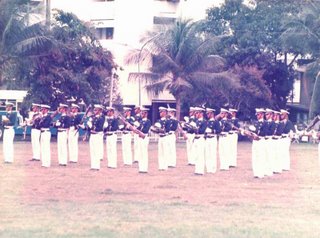
Drill is marching. In ancient history, the most powerful, efficient and
developed empires developed ways of moving organized units of troops
from one place to another on the battlefield, without individuals
getting mixed up with other units. Otherwise, as masses of people
manoeuvred amongst each other individuals would get lost and end up
having to attach themselves to any old unit. A system of flags was
developed so people could identify their own units (and side) on the
field and make their way their correct flag bearer if they got
separated. But sticking to "formed up" squads was better, forming a box
of men who moved as a single body. Overall it meant command systems
were effective - men stayed together and could be commanded as units.
Josephus, a first century Jewish historian, testifies to the
superiority of Roman discipline, and part of that discipline was an
ordered method of moving formed up squads from one place to another.
This discipline facilitates effective realisation of tactical
man-management, and the result is a superior fighting army. [Josephus
p195]
During what historians have reluctantly come to call
“The Military Revolution” European armies between 1550 and 1720 became
generally state-controlled, financed and permanent. “There was a
resultant loss of individuality, with the need for better organization,
good training - especially in drill - and strict discipline” [Becket
& Chandler p40]. Training became an institution.
Since then, drill has become increasingly important as
part of training, discipline and military parades. Goose Stepping was a
form of extreme marching held by German, Prussian, and Russian heads of
military to be an ultimate display of the unbreakable will and
discipline of its soldiers. Most modern marching is not as extreme as
the rigid goose step. Anything that resembling it is now unpopular
because it has became associated with fascism. Nevertheless it is still
used by some countries as a powerful display of military discipline.
Military Drill in the Army is formalized with utmost
precision in the fearsomely bulky Drill Book. In the preamble to the
Drill Book it is "confidently asserted that the foundation of
discipline in battle is based on drill" and that this has been proven
again and again. According to William Barlow, Robert Graves said there
are "three types of troops: those with guts who could not drill; those
good at drill but with no guts and those who had guts and could drill
well. [...]
from http://www.vexen.co.uk/notes/drill.html
Sunday, November 11, 2007
History of the Fancy Drill
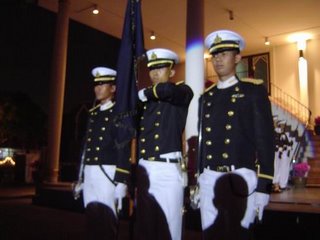
Thursday, November 1, 2007
Fancydrill
The Royal Thai Naval Academy is the origin of the FANCY DRILL. It started many years ago. Now it is popular in every military academy and Armed Forces Academies Preparatory School. We can drill with both rifles and swords, but in the beginning we drilled with M-16 rifles. The Fancy Drill team can have 10 members or more. The Fancy Drill team members have to pass a hard training because M-16 rifles are heavy and they want to show strength. A month before the performance the Fancy Drill team will train in the evening of every day except holidays. In one year the Fancy Drill will have 3 performances: Navy day [Three Anchor party], the Seaman-Farmer Games and Children’s Day. The Fancy Drill can be performed anywhere. The Fancy Drill team members will be trained by the leader of the Fancy Drill team. Music is an important part of the Fancy Drill. Nice music makes the show better. A long time ago, we needed type 88-rifles in the Fancy Drill. They are old and heavy. Then we used MK 33 rifles. Now we use only M-16 rifles because they are modern weapons and easy to drill.
Wednesday, October 31, 2007
gun...

Now we use only M-16 rifles because they are modern weapons and easy to drill.
Tuesday, October 30, 2007
Fixed position style
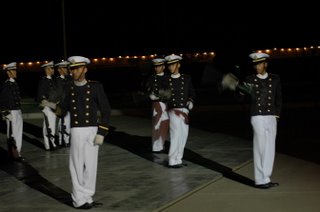 Fixed
position is the style in which every member
twirls his M-16 rifles in a fixed position.
Fixed
position is the style in which every member
twirls his M-16 rifles in a fixed position.
Monday, October 29, 2007
Weapon-checking style
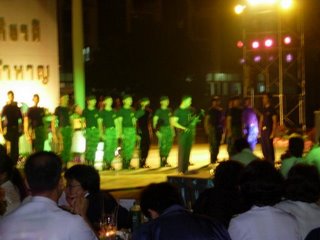 Weapon-checking
style is the style in which every
member stays calm but the leader acts as an inspector, the one who
checks the others’ rifles.
Weapon-checking
style is the style in which every
member stays calm but the leader acts as an inspector, the one who
checks the others’ rifles.
Sunday, October 28, 2007
Korean style or Falling leaves style
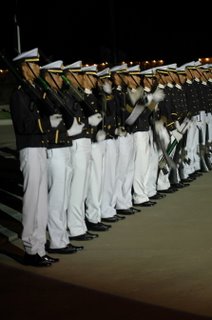 In the Korean style the Fancy drill members
will
perform in one row.
In the Korean style the Fancy drill members
will
perform in one row. Saturday, October 27, 2007
The circle style
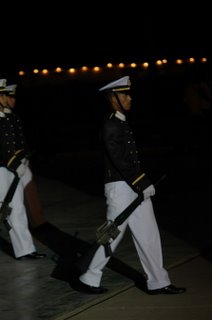
Friday, October 26, 2007
Interview
2) What’s “Fancy drill” in your opinion?
3) What do you think about the “Fancy drill” of the RTNA?
4) What would you improve in the “Fancy drill”?
5) What do you think other people think about the "Fancy drill"?